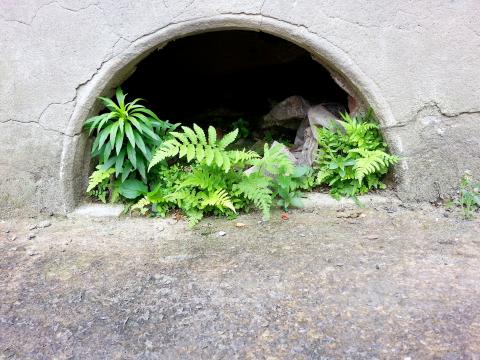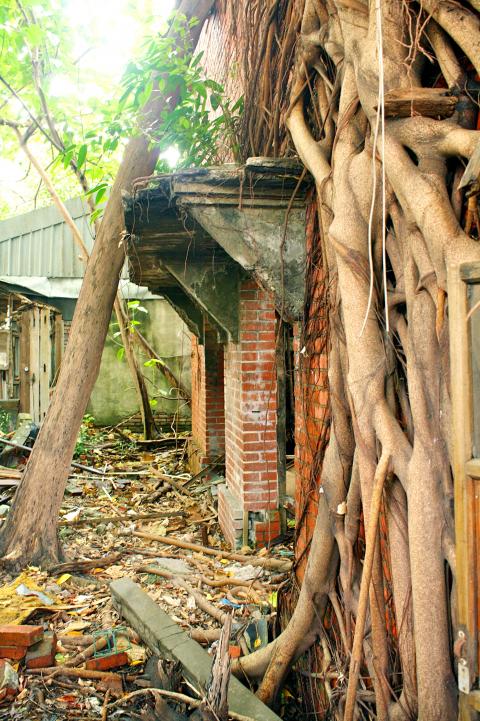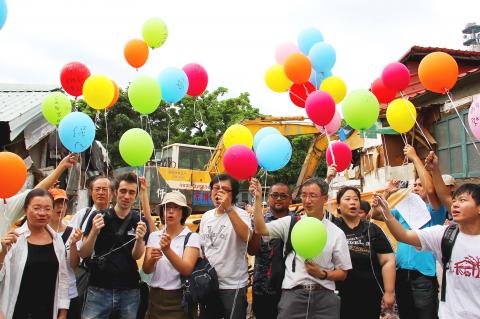Fifty-one year-old Wang Yu-chi (王禹奇) recalls his childhood days with obvious affection. As a kid, he often went to his friend’s house clustered together with other small residences that dotted a narrow path in his neighborhood. Unique to the area, inhabitants built their homes around the trees rather than cutting them down. In the spring, when the peach trees blossomed, the tiny houses were blanketed with petals, as if in a fairytale.
“When my dad wanted to give me a scolding, I would hide here, lie on the trunk growing in the middle of our living room, eat guava and chat with my friend,” says Wang, pointing to a lush tree whose human companions no longer inhabit the same ground.
Wang’s experiences form what was once a bucolic part of life in the Huaguang Community (華光社區), a now nearly deserted neighborhood that will soon be flattened to make way for a glitzy commercial and shopping quarter inspired by Tokyo’s Roppongi district.

Photo courtesy of The Alliance Concerned for the Taipei Prison Settlement
For the past few years, the name Huaguang has been synonymous with controversy due to the central government’s forced eviction of residents. For local residents, however, Huaguang was always known as Prison Gate (監獄口), an epithet from the past that has become central to a preservation campaign by the Alliance Concerned for the Taipei Prison Settlement (台北刑務所群落護育聯盟).
“By calling the place Huaguang, we only see it as a community wrapped in controversy. Many things are omitted, its long history forgotten,” says Huang Shu-mei (黃舒楣), a member of the alliance formed in March by a dozen groups and organizations including the Organization of Urban Re-s (都市改革組織, OURs) and Friends of Trees at Huaguang (華光護樹志工隊) as well as individual professors, cultural workers and concerned citizens.
Been a long time

Photo courtesy of The Alliance Concerned for the Taipei Prison Settlement
Surrounded by present-day Jinhua Street (金華街), Hangzhou South Road (杭州南路) and Jinshan South Road (金山南路), Prison Gate is where Taihoku Prison, the country’s first modern penitentiary, stood. Opened in 1904 by the Japanese colonial government, the Taihoku penitentiary was the grandest among the several prisons built by the Japanese at the turn of the 20th century. It was outfitted with on-site dormitories for prison staff, a public bath, hospitals, farms and a martial-arts hall designed for the prison officers to practice, compete and show off their strength and skills.
Constructed with stones knocked down from city walls built during the Qing Dynasty, the Taihoku Prison offered proof of the progress that Imperial Japan strove to make, according to Huang, a scholar specializing in historical preservation and urban regeneration.
“Defeated by the Western colonizers, Japan sought to become their equal by becoming a colonizer itself. As Japan’s first colony, Taiwan was a perfect place to spread the empire’s power as a newly modernized nation. Today the penitentiary is a good site to examine the ideology behind Japan’s imperial modernity,” she explains.

Photo courtesy of The Alliance Concerned for the Taipei Prison Settlement
Upon its retreat to Taiwan in 1949, the Chinese Nationalist Party (KMT) regime took over the facility and continued to use it as a prison and detention center. From the Japanese colonial period to the White Terror era, countless democracy activists such as Lai Ho (賴和), Chiang Wei-shui (蔣渭水), Chien Chi (簡吉) and Lo Fu-hsing (羅福星) were jailed or executed inside the penitentiary.
In the 1960s and 1970s, the prison was relocated to Taipei’s suburbs, and the original penitentiary was torn down to make way for the headquarters of Chunghwa Telecom (中華電信) and Chunghwa Post (中華郵政). The former penitentiary’s vast farmland was sold and developed into the now bustling area connecting Lishui Street (麗水街) and Yongkang Street (永康街).
Over the decades, the layout of the original complex has remained largely intact. The square-shaped dormitory for prison police, for example, is the only remaining Japanese square-shaped dorm still standing in the country, an indication of the area’s historic importance which is further revealed by the materials that went into constructing the other buildings.

Photo courtesy of The Alliance Concerned for the Taipei Prison Settlement
“During the colonial era, walls were made from bamboo and mud. When the Mainlanders came, the use of bricks became common,” says Wang, pointing to an exposed wall that contains all three of the building materials.
Born and raised in a self-built home next to the martial arts hall, which was consumed by fire in 1994, Wang remembers the imposing architecture, which was three to four stories high and could be seen from a distance. Its concrete foundation survived the fire, giving an idea of the grandeur of the original hall.
Wang says life at the Prison Gate was never affluent. But it did have charm and was sealed in against outsiders because no one would want to live close to the prison except those who worked there or were too poor to live elsewhere. Without running water before the 1960s, inhabitants often used the three public restrooms in the neighborhood as a meeting point to share information or gossip.

Photo courtesy of The Alliance Concerned for the Taipei Prison Settlement
“History leaves traces in space, architecture and landscapes. It is through the history of the space that we learn what has happened and why the place becomes what it is now,” Huang notes.
Setting another bad precedent
Huang says the central government’s decision to raze the century-old neighborhood exposes its blatant disregard for history.
“We pretend that our colonial history didn’t happen. We forget the past and embrace our former colonizer’s Roppongi. It is totally absurd,” she says.
Peng Yang-kae (彭揚凱), secretary-general of OURs, an NGO focusing on urban policy and community-based reform, agrees.
Peng says the Huaguang case illustrates the central government’s disregard for residents and a lack of policy vision. The central government, he adds, is only interested in making a quick buck by leasing the land out to big corporations, and eschews the normal procedures, which involve the local government holding public hearings and seeking public consensus.
“It [the central government] basically tells the Taipei City Government to beat it and skips the whole procedure that allows public opinion to be heard and discussed. Meanwhile, it never tells us any details regarding what it wants to do with the land except for two words: Taipei Roppongi,” Peng says. “A large project like Huaguang will have great impact on the development of the city, but neither the city government nor the citizens have a say in it.”
Another issue surrounding the development project is how public land should be used to benefit the public. For Peng, equating the public interest with the state treasury, the government sounds and acts like a land developer that measures everything in dollars and cents.
“In the past, the government sold the state-owned land. Now it rents it out. But they are never able to answer the question: does it work in the public interest?” he says.
Wang echoes Peng’s sentiment, saying that building a glitzy shopping district can only benefit the well-off.
“Okay so you have 10 people who can shop here. But what about the other 90 people? Don’t they also have the right to use public land? Besides, as the area is rich in history and culture, it should be returned to the public so that people can come here to appreciate history or take a stroll among the trees and old houses wearing flip-flops and a T-shirt,” he says.
Civic engagement
Huang says the preservation campaign for the area’s historical assets and natural environment offers a chance for ordinary citizens like office workers, housewives and retired teachers to understand the past and present of the neighborhood and take part in fighting for what they deem important. After months of preservation efforts, more than 20 trees are now protected under the Taipei City Tree Protection Bylaw (台北市樹木保護自治條例).
For many, the area is a much-needed green space where flora and fauna thrive. According to information compiled by Friends of Trees at Huaguang, more than 20 species of birds have been spotted there. History also leaves traces in the area’s over 40 tree varieties such as Chinese fan palms and Asian bayberries, popular during the colonial era, while residents who came after 1949 planted guava, loquat, starfruit and persimmon.
Meanwhile, the alliance successfully persuaded Taipei’s Department of Cultural Affairs to re-hold the Cultural Assets Review Committee meeting earlier this year. In 2008, a review meeting by the then-cultural committee decided that only a mapping of several historical remains was required before the century-old neighborhood was torn down. Ironically, the Chiang Kai-shek Memorial Hall, located one street away from Huaguang and completed in 1980, was designated a national heritage building in 2007.
In June, the committee designated the former prison walls as a historical heritage site, while the Japanese public bath and several dormitories are listed as historical buildings. The alliance’s appeal to designate the area as a cultural landscape, which allows limited development as long as it respects the local environment and history, was overlooked.
To preservationists like Huang, preserving a few buildings is by no means a way to remember the past.
“They will just be pretty old houses and become Japanese restaurants in the Taipei Roppongi,” she says.

Nine Taiwanese nervously stand on an observation platform at Tokyo’s Haneda International Airport. It’s 9:20am on March 27, 1968, and they are awaiting the arrival of Liu Wen-ching (柳文卿), who is about to be deported back to Taiwan where he faces possible execution for his independence activities. As he is removed from a minibus, a tenth activist, Dai Tian-chao (戴天昭), jumps out of his hiding place and attacks the immigration officials — the nine other activists in tow — while urging Liu to make a run for it. But he’s pinned to the ground. Amid the commotion, Liu tries to

The slashing of the government’s proposed budget by the two China-aligned parties in the legislature, the Chinese Nationalist Party (KMT) and Taiwan People’s Party (TPP), has apparently resulted in blowback from the US. On the recent junket to US President Donald Trump’s inauguration, KMT legislators reported that they were confronted by US officials and congressmen angered at the cuts to the defense budget. The United Daily News (UDN), the longtime KMT party paper, now KMT-aligned media, responded to US anger by blaming the foreign media. Its regular column, the Cold Eye Collection (冷眼集), attacked the international media last month in

A pig’s head sits atop a shelf, tufts of blonde hair sprouting from its taut scalp. Opposite, its chalky, wrinkled heart glows red in a bubbling vat of liquid, locks of thick dark hair and teeth scattered below. A giant screen shows the pig draped in a hospital gown. Is it dead? A surgeon inserts human teeth implants, then hair implants — beautifying the horrifyingly human-like animal. Chang Chen-shen (張辰申) calls Incarnation Project: Deviation Lovers “a satirical self-criticism, a critique on the fact that throughout our lives we’ve been instilled with ideas and things that don’t belong to us.” Chang

Feb. 10 to Feb. 16 More than three decades after penning the iconic High Green Mountains (高山青), a frail Teng Yu-ping (鄧禹平) finally visited the verdant peaks and blue streams of Alishan described in the lyrics. Often mistaken as an indigenous folk song, it was actually created in 1949 by Chinese filmmakers while shooting a scene for the movie Happenings in Alishan (阿里山風雲) in Taipei’s Beitou District (北投), recounts director Chang Ying (張英) in the 1999 book, Chang Ying’s Contributions to Taiwanese Cinema and Theater (打鑼三響包得行: 張英對台灣影劇的貢獻). The team was meant to return to China after filming, but